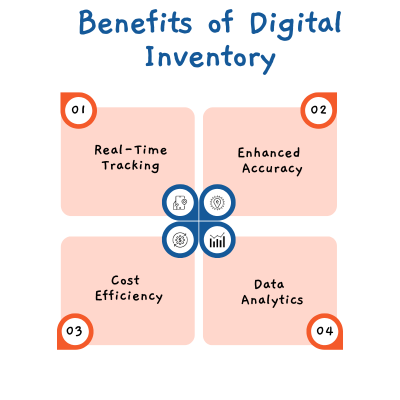Handyman Services List To Simplify Your Business Operations Serveiz |...
Read MoreDigital Inventory Management System to Enhance Efficiency
Serveiz | Blog
For businesses in various industries, digital inventory management is now more important than ever. In contrast to traditional methods, a digital inventory management system uses advanced technologies to provide real-time tracking, enhanced accuracy, and seamless inventory management workflows.
This blog explores the fundamentals of digital inventory and offers helpful suggestions for businesses ready to embrace this ground-breaking transformation.
What is Digital Inventory Management?
Digital inventory management is the process of managing and tracking a company’s products or assets through digital technology. Digital inventory, unlike conventional methods, uses software and automated systems to track stock levels, sales, and order fulfillment in real time. Traditional methods use manual recording and checks. With accuracy, efficiency, and streamlined processes, this technological breakthrough has completely changed how firms manage their inventory.
Traditional vs digital inventory: What’s the difference?
Traditional inventory management involves complicated and error-prone manual tracking of products. In contrast, digital inventory management automates the tracking process by using software platforms, barcoding, and RFID (Radio Frequency Identification). This advancement allows companies to quickly make data-driven decisions while also reducing human error rates and delivering real-time information.
How Digital Inventories Can Help Your Organization

Businesses can benefit from digital inventory management, including:
- Real-Time Tracking: Companies can maintain their stock levels in real-time, avoiding stock outs or overstocking issues.
- Enhanced Accuracy: Automation lowers human error rates, assuring accurate product tracking.
- Cost efficiency: Automated systems reduce storage expenses and excess inventory by avoiding overstock.
- Data analytics: Digital inventory systems gather useful data that gives businesses insights into consumer preferences, demand trends, and inventory turnover rates.
Significant Features of Digital Inventory Management Systems
- Barcode scanning: Digital systems use barcodes to identify products quickly and easily, increasing inventory management effectiveness.
- Demand Forecasting: By using previous data to predict future demand, these technologies help organizations successfully manage their inventories.
- Interaction with Sales Channels: Automated order processing and inventory updates are made possible by seamless integration with e-commerce sites and other retail outlets.
- Multi-Location Inventory Management: For companies with several locations, digital systems streamline inventory management, assuring consistency across all branches.
How Digital Inventory Management Works
Digital inventory management helps businesses keep track of their products using digital technology. Software, barcodes, and RFID tags replace work that would be done manually. Here’s how it works:
- Tracking Items: Each product or part gets a special code like a barcode. A technician can scan a code to quickly find out what a part is, how many are left, and where it’s stored when they need it.
- Updating in Real Time: As technicians use or add parts during jobs, the system updates right away. This helps make sure there are always enough parts for the next job.
- Automating Tasks: Some things, like counting parts or ordering more when they’re running low, can be done automatically. This saves time and makes mistakes less likely.
- Working Together: The system can talk to other tools a business uses, like phones or computers. This helps everyone know what’s going on and makes sure parts get to where they’re needed on time.
Digital Inventory Management for Different Businesses
Big companies and small ones both use digital inventory management.
- For Big Companies: They use it at lots of places and with complicated supply chains. This helps them keep track of parts everywhere and make sure they have enough for all their jobs.
- For Smaller Businesses(SMB’s): For HVAC companies, digital inventory management helps keep track of parts and equipment, making sure they have what they need. It helps with ordering and controlling costs, and can be changed to fit their budget. This system makes their work easier and helps them save money.
Tips for Choosing the Right Digital Inventory Management System
When choosing a Digital Inventory Management System, consider the following
Choose apps that automate inventory management:
Choose applications that automate inventory control. Prioritize automating repetitive processes like data entry, order processing, and stock level updates when considering digital inventory software. Automation decreases human error while saving time.
Choose Apps With Real-time Reporting and Analytics:
Choose a system with excellent reporting and analytics capabilities. Data-driven decision-making is aided by real-time insights about inventory turnover, demand trends, and supplier efficiency, which results in more effective inventory management methods.
Select systems with encryption and regular backups for data security:
Give the highest priority to systems with strong data security precautions. Data about your inventory is private and essential to operate your business. When selecting the ideal system, it is crucial to guarantee reliability and security.
Customizing Your System to Fit Your Business
Every business is different, so digital inventory systems can be changed to fit what a business needs. Here’s how:
- Figure Out What You Need: Look at what kind of work you do and what you need to do it. Do you have a lot of different parts? Do you work in one place or many?
- Make Changes: Choose a system that can be changed to fit how your business works. You might want to change what it shows you or how it does things.
- Plan for the Future: Your business might get bigger or change how it works. Make sure the system you pick can grow with you.
- Get Help if You Need It: Make sure your team knows how to use the system, and there’s someone you can ask if there’s a problem.
- Keep Getting Better: Even after you start using the system, look for ways to make it work even better for you.
By making sure your digital inventory system fits what your business needs, you can make your work run more smoothly and grow better. Read our blog on Essentials of Inventory Management in Field Service Operations.
Find the right digital inventory partner:
Look for companies with a solid track record, top-notch customer service, and a solution tailored to your company’s requirements. Effective cooperation guarantees a seamless transition and continued support, maximizing digital inventory management benefits.
Finding the ideal digital inventory partner for your company becomes essential according to these guidelines. Serveiz, a leader in digital inventory management, meets these requirements precisely. Serveiz stands out for its customization capabilities. Rather than providing generic packages, Serveiz evaluates your company’s needs and develops customized strategies.
Summary
The right platform transforms how companies operate, from automation that cuts down on errors to real-time analytics pointing decisions. Selecting a trustworthy partner is crucial since, in today’s competitive businesses, doing so is a smart move towards sustained growth and unparalleled customer satisfaction.


